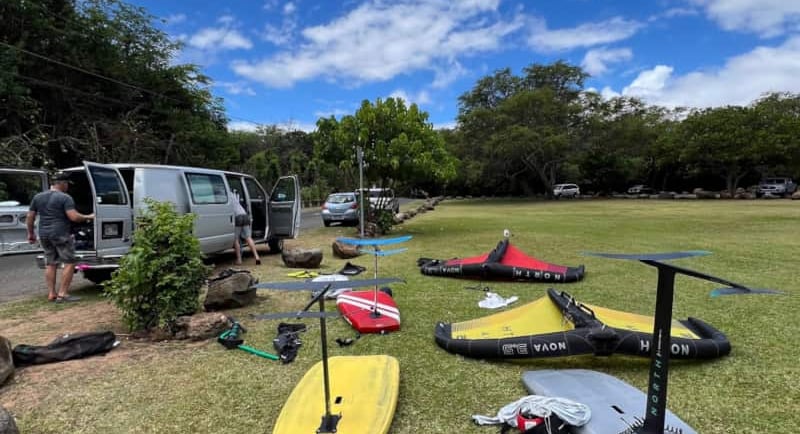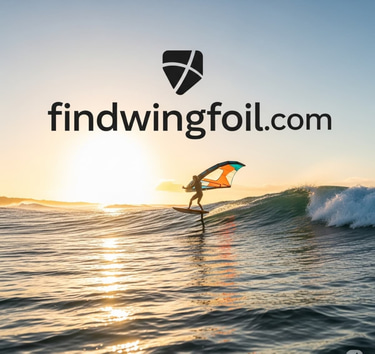The Blow-Up Battle: Inflatable vs. Hard Foil Boards – Which One Will Lift Your Ride?
Dive into the ultimate guide comparing inflatable and hard wing foil boards! Unsure which board is right for your wing foiling adventures? We break down the pros and cons of portability, performance, durability, and more to help you choose your perfect ride and get soaring on the water.
7/14/20255 min read


The world of watersports is constantly evolving, and few innovations have captured the imagination quite like foiling. Gliding silently above the water, seemingly defying gravity – it's an experience that’s equal parts exhilarating and serene. And at the heart of this revolution are foil boards. But when it comes to choosing your chariot for the skies, a new contender has emerged, challenging the traditional fiberglass and carbon fiber: the inflatable wing foil board.
For newcomers and seasoned riders alike, the choice between an inflatable wing foil board and its rigid counterparts can be a head-scratcher. Both offer unique advantages and drawbacks that can significantly impact your learning curve, travel convenience, and overall enjoyment on the water. So, let’s dive deep into the pros and cons of these two distinct categories, helping you make an informed decision for your foiling adventures.
The Inflatable Advantage: Riding on Air
The inflatable wing foil board has taken the market by storm for several compelling reasons, primarily centered around convenience and accessibility.
Pros of Inflatable Wing Foil Boards:
Portability & Storage: The Ultimate Travel Companion. This is arguably the biggest selling point of an inflatable wing foil board. Deflated and rolled up, they can fit into a backpack or a relatively small duffel bag. Imagine tossing your entire foiling setup – board, wing, and foil – into the trunk of your car with room to spare, or even checking it as luggage on an airplane without incurring exorbitant oversized baggage fees. For apartment dwellers, those with limited garage space, or anyone who frequently travels to their foiling spots, this is a game-changer. Hard boards, by contrast, are bulky and often require roof racks or specialized transport.
Durability & Ding Resistance: Bounce, Don't Break. While it might seem counterintuitive, inflatable wing foil boards often prove surprisingly resilient to minor impacts. Their pliable nature means they can absorb bumps and knocks from rocks, docks, or even accidental drops without sustaining the kind of catastrophic damage (like cracks or punctures that require immediate repair) that a hard board might. Beginners, especially, will appreciate this forgiveness as they navigate shallow waters or experience occasional tumbles. Of course, a sharp object can still puncture them, but general wear and tear is often less impactful.
Softness & Safety: A Gentler Learning Curve. For those just dipping their toes into the world of foiling, the soft, cushioned surface of an inflatable wing foil board offers a comforting advantage. Falls are an inevitable part of the learning process, and landing on a softer surface is considerably less jarring than hitting a rigid deck. This can boost confidence and encourage more fearless experimentation, ultimately accelerating skill development.
Cost-Effectiveness (Often): More Bang for Your Buck. In many cases, inflatable wing foil boards tend to be more affordable than their rigid counterparts, especially at entry-level prices. This can make foiling more accessible to a wider audience, allowing aspiring riders to get started without a hefty initial investment. While high-end inflatables can match the price of some hard boards, the barrier to entry is generally lower.
Versatility: Many inflatable wing foil boards are designed with higher volume, making them more stable for learning and also more adaptable to various conditions. Some can even be used for paddleboarding or as a stable platform for other watersports when not being foiled.
The Hard Truth: Where Rigid Boards Reign
Despite the compelling advantages of inflatables, traditional hard foil boards continue to be the choice of many experienced riders and those seeking peak performance.
Cons of Inflatable Wing Foil Boards (and Pros of Hard Boards):
Performance & Stiffness: The Direct Connection. This is where hard boards truly shine. The rigid construction of a fiberglass, carbon fiber, or composite foil board offers an unparalleled direct connection between the rider, the board, and the foil. This stiffness translates to a more immediate and precise transfer of power, allowing for sharper turns, higher speeds, and a more responsive feel on the water. Inflatables, even highly pressurized ones, will always have a slight degree of flex, which can dampen performance and make advanced maneuvers feel less crisp.
Pumping & Take-Off Efficiency: Effortless Lift. Pumping the board to generate lift and get on foil requires a stiff platform to efficiently transfer energy to the foil. Hard boards excel at this, allowing riders to get up on foil with less effort and in lighter winds. The inherent flex of an inflatable wing foil board can absorb some of this pumping energy, making it slightly more challenging to get airborne, especially for heavier riders or in marginal conditions.
Durability (Long-Term & Major Damage): Not Indestructible. While good at shrugging off minor dings, a major puncture or seam failure on an inflatable wing foil board can be a significant issue, often requiring specialized repair or even replacement. Hard boards, while susceptible to dings, can often be repaired locally with fiberglass or epoxy kits, and a well-maintained hard board can last for many years, even decades.
Aesthetics & Resale Value: Sleek and Solid. There's no denying the sleek, sculpted lines of a high-performance hard foil board. They often feature intricate designs and finishes that appeal to riders who appreciate the craftsmanship. From a resale perspective, a well-maintained hard board often retains its value better than an inflatable, especially as technology in inflatables continues to evolve rapidly.
Setup Time & Effort: Pump It Up! While convenient for storage, setting up an inflatable wing foil board requires inflating it to a high PSI, which can take several minutes and a fair amount of physical effort, especially if using a hand pump. While electric pumps exist, they add another piece of gear to carry and manage. Hard boards are ready to go once the foil is attached – a quick and effortless process.
Foil Box Integrity: The connection point between the board and the foil is crucial. Hard boards typically have integrated, reinforced foil boxes that provide a rock-solid connection. While inflatables have made significant strides in this area with reinforced patches and plate systems, some riders may still perceive a slight compromise in the absolute rigidity of the foil connection compared to a hard board.
Who Should Choose What?
The "best" board ultimately depends on your individual needs, skill level, and priorities.
You should consider an Inflatable Wing Foil Board if:
Portability is paramount: You travel frequently, have limited storage space, or want to easily transport your gear.
You're a beginner: The added softness and durability will be forgiving as you learn.
Budget is a major consideration: You're looking for a more affordable entry point into foiling.
You prioritize casual cruising and fun over peak performance.
"Getting Started with Wing Foiling: Your Essential Gear Guide"
You should consider a Hard Foil Board if:
Performance is your top priority: You crave maximum responsiveness, speed, and precision for advanced maneuvers.
You're an experienced rider: You can appreciate and leverage the subtle differences in feel and control.
You have ample storage and transportation options.
You want a board with potentially longer lifespan and higher resale value.
The Hybrid Horizon and Future Trends
It's worth noting that the lines are blurring. Manufacturers are constantly innovating, developing technologies that bridge the gap between these two categories. We're seeing inflatable wing foil boards with increasingly stiff construction, improved foil box integration, and refined shapes that push performance boundaries. Conversely, some hard boards are being designed with more compact dimensions for easier transport.
The future of foil board design will likely continue to see advancements in materials and construction, potentially offering even more versatile options that combine the best attributes of both inflatable and hard boards.
The Final Verdict: Your Ride, Your Choice
Ultimately, there's no single "best" foil board. The ideal choice for you will depend on your personal circumstances and aspirations. If you prioritize convenience, ease of transport, and a forgiving learning experience, an inflatable wing foil board is an excellent choice that will get you on the water and flying with minimal hassle. If you're a seasoned rider chasing performance, precision, and the ultimate connection to the water, a hard foil board will likely remain your weapon of choice.
Whichever path you choose, the world of foiling promises an unparalleled sensation of freedom and exhilaration. So, weigh your options, consider your needs, and get ready to lift off!
Connect
Explore wing foiling schools, vendors, and events.
Support
Learn
801-554-1050
© 2025. All rights reserved.
